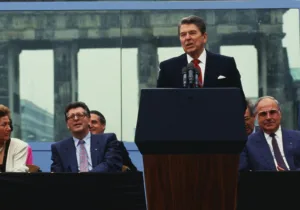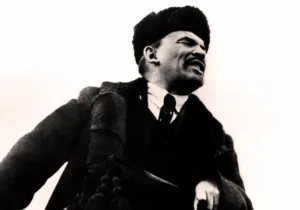In the wake of the celebrations of Normandy and the nostalgia and celebration that have accompanied the speeches and honors paid to veterans of the Second World War, it’s important to remember the arduous and far-from-certain world that met America and its European allies after the war. The contest with the Soviets began before the war ended, and fear about a further war between the US and Russia was very real. The dropping of the atomic bombs on Hiroshima and Nagasaki and the subsequent successful detonations by the Russians set the stage for the superpower contest that was to define the world for the next 40 years.
During President Donald Trump’s recent state visit to the UK, Prime Minister Theresa May gave Trump a framed copy of the Atlantic Charter as an intentional reminder of the importance of international institutions to a president who has often been critical of those very institutions. The charter was mostly a piece of political propaganda by the British to strengthen ties with America.
With the election of Barack Obama and his successor, Donald Trump, America has been in retreat. Obama was elected, in part, for his opposition to the Iraq War and his promise to end wars in Afghanistan and Iraq. It was time for the troops to come home. Obama’s foreign policy doctrine, pithily formulated as “don’t do stupid sh*t,” was hardly a rallying call for American engagement. And though Democrats tend to favor international engagement and are more enthusiastic about the role of international institutions, the party as a whole has drifted toward a position that disassociates that engagement from any form of hard power. Our hand should only ever be open in friendship.
Donald Trump took the iconoclastic stance as a Republican opposing the Iraq War, even insinuating during the South Carolina primary debate that George W. Bush may have lied to get us into the war. In office, Trump’s “America First” foreign policy has been inconsistent, but he has similar intuitions to those of his predecessor, even if for different reasons and couched in different rhetoric. America must pull back and let the world handle its own problems. Both are realists of a sort.
The Miracle of the Postwar Order
Into this moment of soul-searching in the American public about its role in the world, John Lewis Gaddis’ recent history of the Cold War, The Cold War, provides a much-needed perspective. The once dominant American internationalist impulse is being challenged from within both major political parties, whether from the Bernie Sanders wing or the Rand Paul wing. There once was a time when internationalism, though not the airy internationalism of United Nations apologists, was the American consensus in both parties. It was an internationalism that took it as America’s duty to uphold the international order and push back against the Soviet Union’s attempt to destabilize that order and expand its own sphere of influence. It was a thoroughly realistic internationalism that was sober and realistic about its own abilities and limitations, even when it overreached.
There are good reasons to support the burgeoning nationalist impulse in America and Europe. The criticisms leveled against internationalism—that we should not be the world’s police, that our allies aren’t pulling their weight, and that we should put American interests first—are legitimate and often ring true. Both Bush and Obama failed to sell the American public on America’s traditional role as the guarantor of the international order. But internationalism comes in different flavors, and the Cold War internationalism that Gaddis describes is quite different from the internationalism that is championed today.
The Cold War is a book that summarizes much of Gaddis’ scholarship over the years, packed into a condensed and popular history. Gaddis is flying at 30,000 feet rather than at low altitudes and moves quickly from major events. The book works very much as both a nice overview of Gaddis’ oeuvre and as a defense of America’s involvement in world affairs from World War II up to the late 1980s.
Though not one to pass over the warts and problems in the history of America’s foreign policy, Gaddis clearly develops the argument that American power was not only necessary but also good. Placed next to our superpower competitor, American democratic capitalism, even with its clear downsides and weaknesses, shows its superiority to its communist competitor. In our current circus-like political climate, it’s hard for us to escape our own cynicism, but the defeat of communism and the ascendency of democracy and free markets is nothing short of a miracle, one that America played the leading role in bringing about.
The Long View
Gaddis makes sure to give credit where credit is due. Both Japan and Germany are given ample praise for moving from authoritarian dictatorships to two of the most prosperous and functional democracies in the world—a serious accomplishment, given the lack of any democratic culture in either country. While seeking to influence both countries, the US gave Germany and Japan substantial freedom to choose their own destinies and devise their own form of democratic capitalism, which often veered from the American model. It was far from a foregone conclusion that this would happen. While people remember the postwar period as an age of optimism and prosperity, the world was far from secure and stable.
While today there are calls for American troops to come home, Gaddis reminds his readers that it took South Korea, Japan, and Germany decades—in South Korea’s case, almost half a century—before a genuine democratic and free market society emerged. To be sure, these situations were unique and do not provide us a clear road map in bringing the benefits of democracy and free markets to the rest of the world. However, they are important reminders that we ought to learn from.…
Spontaneity
One aspect of the American approach to influencing other countries was a bedrock conviction in the importance of spontaneity. Gaddis contrasts the American and Soviet approaches:
Both ideologies that defined those worlds were meant to offer hope: that is why one has an ideology in the first place. One of them, however, had come to depend, for its functioning, upon the creation of fear. The other had no need to do so. Therein lay the basic ideological asymmetry of the Cold War.
The Americans had an advantage because their general approach was more hands-off, and they had more confidence that once people experienced the benefits of capitalism and democracy, their system would be chosen. So unlike the Soviet model, there would be no need to impose a top-down system.
Like the Soviets, the Americans used their own domestic model in Japan and Germany, but the great virtue of the American model was that it was flexible, adaptable, and nimble. This was a stark contrast to the Soviets, who were guided by fear and sought to impose their model of government and economy through fear:
The Americans had another advantage over the Russians, however, that had nothing to do with material capabilities: it was their pragmatic reliance on spontaneity. Whatever its roots—whether in market economics or democratic politics or simply national culture—they never accepted the idea that wisdom, or even common sense, could be found only at the top. They were impatient with hierarchy, at ease with flexibility, and profoundly distrustful of the notion that theory should determine practice rather than the other way around.
In contrast, the Russian model was profoundly fearful, expressing its own lack of confidence in its core convictions.
Lessons for Today
As we look out at the world today, Americans need to recount the lessons of the Cold War that Gaddis helpfully brings to our attention. The world that America took leadership in building did not happen overnight. We need to remember that. Also, the confidence that defined American convictions about the value of democracy and capitalism were not blind devotion to an ideology. Americans believed they would actually bring a better world into existence, and they did. As we face the future and the unknowns that they present us with, we must remember these past examples:
So the Americans came up with a third alternative. They would revive the German and Japanese economies, thereby securing the future of capitalism in those surrounding regions. But they would also transform the Germans and Japanese into democrats…
But because the domestic institutions of the United States could hardly have been more different from those of the Soviet Union, the Americans’ objectives in running their occupation could hardly have been less similar…
The Americans had another advantage over the Russians, however, that had nothing to do with material capabilities: it was their pragmatic reliance on spontaneity. Whatever its roots-whether in market economics or democratic politics or simply national culture—they never accepted the idea that wisdom, or even common sense, could be found only at the top. They were impatient with hierarchy, at ease with flexibility, and profoundly distrustful of the notion that theory should determine practice rather than the other way around.
The Soviets suppressed spontaneity lest it challenged their basis for rule. Fear competed against hope.
Daniel Strand is a postdoctoral fellow in the Center for Political Thought and Leadership at the Arizona State University. His scholarly interests are in the history of political thought, religion and politics, and the thought of St. Augustine of Hippo.
Photo Credit: Berlin Wall graffiti shows “False Liberty” drawing, 1986. By Nancy Wong, via Wikimedia Commons.







 Live in the DC area? Sign-up for Providence's in-person events list!
Live in the DC area? Sign-up for Providence's in-person events list!